Peng-Jen Chen
Textless Acoustic Model with Self-Supervised Distillation for Noise-Robust Expressive Speech-to-Speech Translation
Jun 04, 2024Abstract:In this paper, we propose a textless acoustic model with a self-supervised distillation strategy for noise-robust expressive speech-to-speech translation (S2ST). Recently proposed expressive S2ST systems have achieved impressive expressivity preservation performances by cascading unit-to-speech (U2S) generator to the speech-to-unit translation model. However, these systems are vulnerable to the presence of noise in input speech, which is an assumption in real-world translation scenarios. To address this limitation, we propose a U2S generator that incorporates a distillation with no label (DINO) self-supervised training strategy into it's pretraining process. Because the proposed method captures noise-agnostic expressivity representation, it can generate qualified speech even in noisy environment. Objective and subjective evaluation results verified that the proposed method significantly improved the performance of the expressive S2ST system in noisy environments while maintaining competitive performance in clean environments.
Seamless: Multilingual Expressive and Streaming Speech Translation
Dec 08, 2023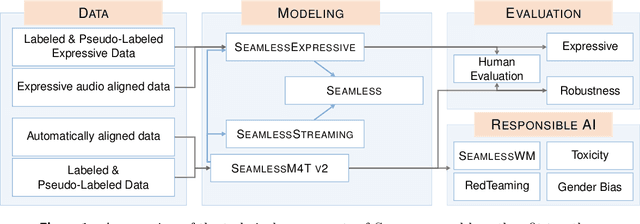
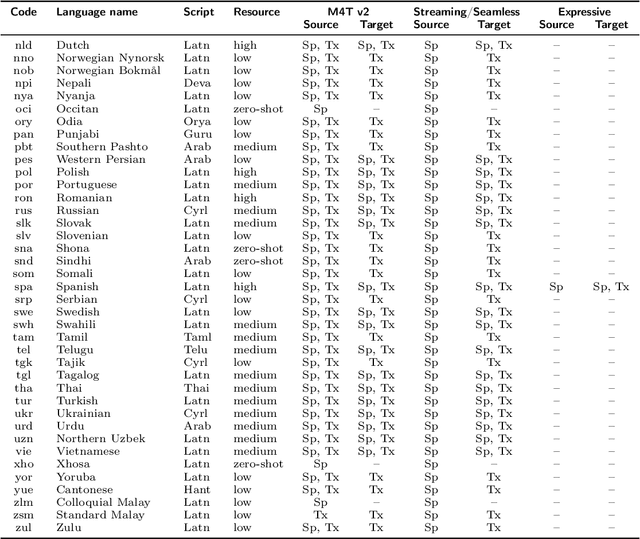

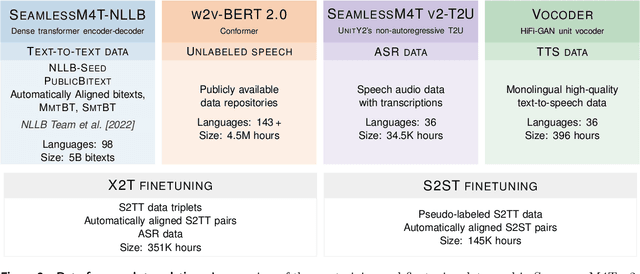
Abstract:Large-scale automatic speech translation systems today lack key features that help machine-mediated communication feel seamless when compared to human-to-human dialogue. In this work, we introduce a family of models that enable end-to-end expressive and multilingual translations in a streaming fashion. First, we contribute an improved version of the massively multilingual and multimodal SeamlessM4T model-SeamlessM4T v2. This newer model, incorporating an updated UnitY2 framework, was trained on more low-resource language data. SeamlessM4T v2 provides the foundation on which our next two models are initiated. SeamlessExpressive enables translation that preserves vocal styles and prosody. Compared to previous efforts in expressive speech research, our work addresses certain underexplored aspects of prosody, such as speech rate and pauses, while also preserving the style of one's voice. As for SeamlessStreaming, our model leverages the Efficient Monotonic Multihead Attention mechanism to generate low-latency target translations without waiting for complete source utterances. As the first of its kind, SeamlessStreaming enables simultaneous speech-to-speech/text translation for multiple source and target languages. To ensure that our models can be used safely and responsibly, we implemented the first known red-teaming effort for multimodal machine translation, a system for the detection and mitigation of added toxicity, a systematic evaluation of gender bias, and an inaudible localized watermarking mechanism designed to dampen the impact of deepfakes. Consequently, we bring major components from SeamlessExpressive and SeamlessStreaming together to form Seamless, the first publicly available system that unlocks expressive cross-lingual communication in real-time. The contributions to this work are publicly released and accessible at https://github.com/facebookresearch/seamless_communication
SeamlessM4T-Massively Multilingual & Multimodal Machine Translation
Aug 23, 2023
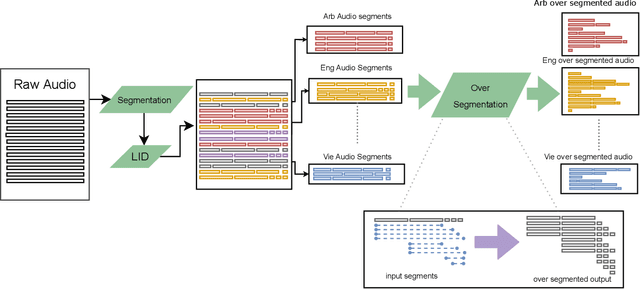
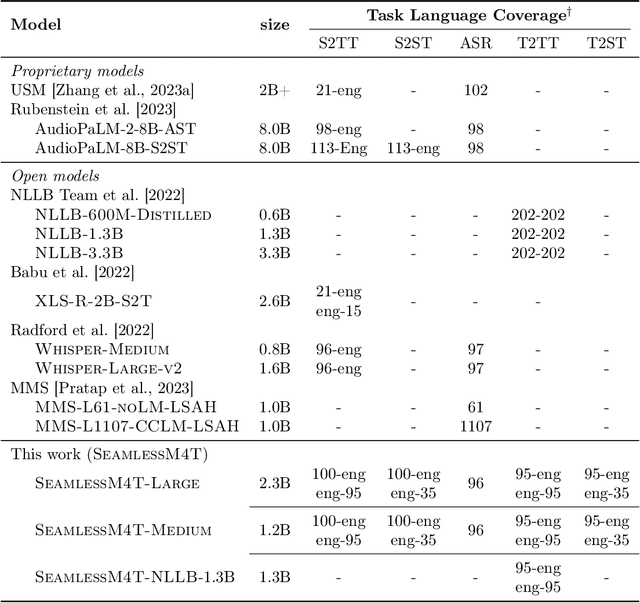
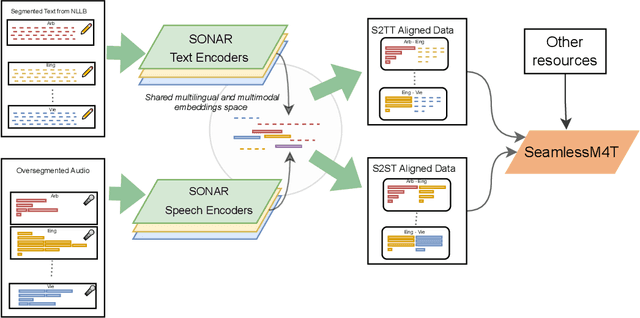
Abstract:What does it take to create the Babel Fish, a tool that can help individuals translate speech between any two languages? While recent breakthroughs in text-based models have pushed machine translation coverage beyond 200 languages, unified speech-to-speech translation models have yet to achieve similar strides. More specifically, conventional speech-to-speech translation systems rely on cascaded systems that perform translation progressively, putting high-performing unified systems out of reach. To address these gaps, we introduce SeamlessM4T, a single model that supports speech-to-speech translation, speech-to-text translation, text-to-speech translation, text-to-text translation, and automatic speech recognition for up to 100 languages. To build this, we used 1 million hours of open speech audio data to learn self-supervised speech representations with w2v-BERT 2.0. Subsequently, we created a multimodal corpus of automatically aligned speech translations. Filtered and combined with human-labeled and pseudo-labeled data, we developed the first multilingual system capable of translating from and into English for both speech and text. On FLEURS, SeamlessM4T sets a new standard for translations into multiple target languages, achieving an improvement of 20% BLEU over the previous SOTA in direct speech-to-text translation. Compared to strong cascaded models, SeamlessM4T improves the quality of into-English translation by 1.3 BLEU points in speech-to-text and by 2.6 ASR-BLEU points in speech-to-speech. Tested for robustness, our system performs better against background noises and speaker variations in speech-to-text tasks compared to the current SOTA model. Critically, we evaluated SeamlessM4T on gender bias and added toxicity to assess translation safety. Finally, all contributions in this work are open-sourced and accessible at https://github.com/facebookresearch/seamless_communication
A Holistic Cascade System, benchmark, and Human Evaluation Protocol for Expressive Speech-to-Speech Translation
Jan 25, 2023



Abstract:Expressive speech-to-speech translation (S2ST) aims to transfer prosodic attributes of source speech to target speech while maintaining translation accuracy. Existing research in expressive S2ST is limited, typically focusing on a single expressivity aspect at a time. Likewise, this research area lacks standard evaluation protocols and well-curated benchmark datasets. In this work, we propose a holistic cascade system for expressive S2ST, combining multiple prosody transfer techniques previously considered only in isolation. We curate a benchmark expressivity test set in the TV series domain and explored a second dataset in the audiobook domain. Finally, we present a human evaluation protocol to assess multiple expressive dimensions across speech pairs. Experimental results indicate that bi-lingual annotators can assess the quality of expressive preservation in S2ST systems, and the holistic modeling approach outperforms single-aspect systems. Audio samples can be accessed through our demo webpage: https://facebookresearch.github.io/speech_translation/cascade_expressive_s2st.
UnitY: Two-pass Direct Speech-to-speech Translation with Discrete Units
Dec 15, 2022Abstract:Direct speech-to-speech translation (S2ST), in which all components can be optimized jointly, is advantageous over cascaded approaches to achieve fast inference with a simplified pipeline. We present a novel two-pass direct S2ST architecture, {\textit UnitY}, which first generates textual representations and predicts discrete acoustic units subsequently. We enhance the model performance by subword prediction in the first-pass decoder, advanced two-pass decoder architecture design and search strategy, and better training regularization. To leverage large amounts of unlabeled text data, we pre-train the first-pass text decoder based on the self-supervised denoising auto-encoding task. Experimental evaluations on benchmark datasets at various data scales demonstrate that UnitY outperforms a single-pass speech-to-unit translation model by 2.5-4.2 ASR-BLEU with 2.83x decoding speed-up. We show that the proposed methods boost the performance even when predicting spectrogram in the second pass. However, predicting discrete units achieves 2.51x decoding speed-up compared to that case.
Speech-to-Speech Translation For A Real-world Unwritten Language
Nov 11, 2022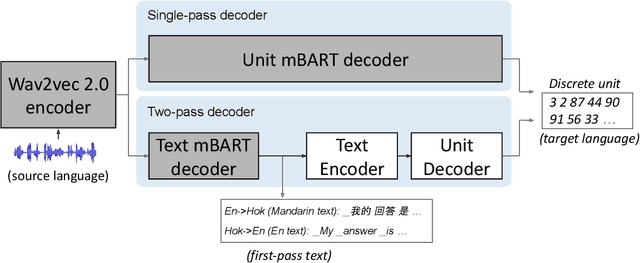


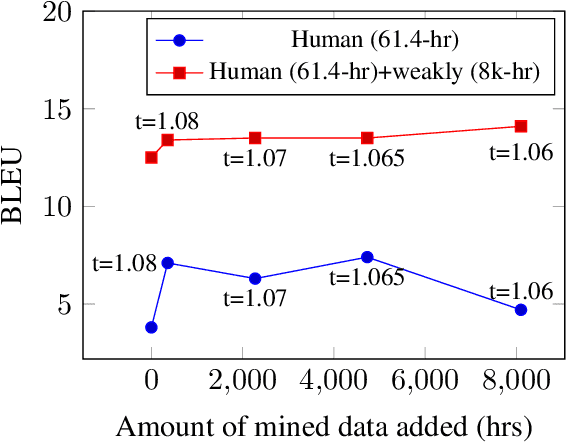
Abstract:We study speech-to-speech translation (S2ST) that translates speech from one language into another language and focuses on building systems to support languages without standard text writing systems. We use English-Taiwanese Hokkien as a case study, and present an end-to-end solution from training data collection, modeling choices to benchmark dataset release. First, we present efforts on creating human annotated data, automatically mining data from large unlabeled speech datasets, and adopting pseudo-labeling to produce weakly supervised data. On the modeling, we take advantage of recent advances in applying self-supervised discrete representations as target for prediction in S2ST and show the effectiveness of leveraging additional text supervision from Mandarin, a language similar to Hokkien, in model training. Finally, we release an S2ST benchmark set to facilitate future research in this field. The demo can be found at https://huggingface.co/spaces/facebook/Hokkien_Translation .
Simple and Effective Unsupervised Speech Translation
Oct 18, 2022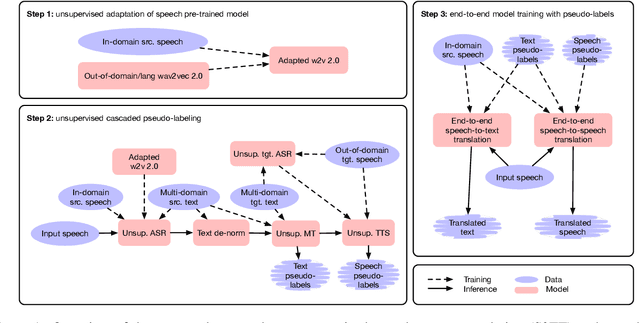
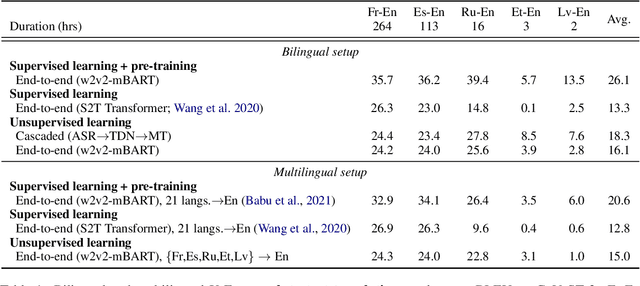
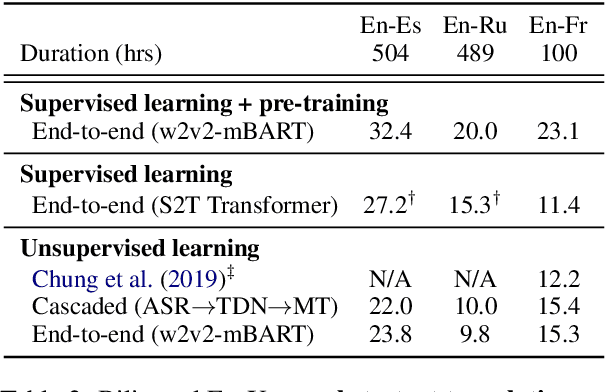

Abstract:The amount of labeled data to train models for speech tasks is limited for most languages, however, the data scarcity is exacerbated for speech translation which requires labeled data covering two different languages. To address this issue, we study a simple and effective approach to build speech translation systems without labeled data by leveraging recent advances in unsupervised speech recognition, machine translation and speech synthesis, either in a pipeline approach, or to generate pseudo-labels for training end-to-end speech translation models. Furthermore, we present an unsupervised domain adaptation technique for pre-trained speech models which improves the performance of downstream unsupervised speech recognition, especially for low-resource settings. Experiments show that unsupervised speech-to-text translation outperforms the previous unsupervised state of the art by 3.2 BLEU on the Libri-Trans benchmark, on CoVoST 2, our best systems outperform the best supervised end-to-end models (without pre-training) from only two years ago by an average of 5.0 BLEU over five X-En directions. We also report competitive results on MuST-C and CVSS benchmarks.
Enhanced Direct Speech-to-Speech Translation Using Self-supervised Pre-training and Data Augmentation
Apr 06, 2022



Abstract:Direct speech-to-speech translation (S2ST) models suffer from data scarcity issues as there exists little parallel S2ST data, compared to the amount of data available for conventional cascaded systems that consist of automatic speech recognition (ASR), machine translation (MT), and text-to-speech (TTS) synthesis. In this work, we explore self-supervised pre-training with unlabeled speech data and data augmentation to tackle this issue. We take advantage of a recently proposed speech-to-unit translation (S2UT) framework that encodes target speech into discrete representations, and transfer pre-training and efficient partial finetuning techniques that work well for speech-to-text translation (S2T) to the S2UT domain by studying both speech encoder and discrete unit decoder pre-training. Our experiments show that self-supervised pre-training consistently improves model performance compared with multitask learning with a BLEU gain of 4.3-12.0 under various data setups, and it can be further combined with data augmentation techniques that apply MT to create weakly supervised training data. Audio samples are available at: https://facebookresearch.github.io/speech_translation/enhanced_direct_s2st_units/index.html .
Textless Speech-to-Speech Translation on Real Data
Dec 15, 2021



Abstract:We present a textless speech-to-speech translation (S2ST) system that can translate speech from one language into another language and can be built without the need of any text data. Different from existing work in the literature, we tackle the challenge in modeling multi-speaker target speech and train the systems with real-world S2ST data. The key to our approach is a self-supervised unit-based speech normalization technique, which finetunes a pre-trained speech encoder with paired audios from multiple speakers and a single reference speaker to reduce the variations due to accents, while preserving the lexical content. With only 10 minutes of paired data for speech normalization, we obtain on average 3.2 BLEU gain when training the S2ST model on the \vp~S2ST dataset, compared to a baseline trained on un-normalized speech target. We also incorporate automatically mined S2ST data and show an additional 2.0 BLEU gain. To our knowledge, we are the first to establish a textless S2ST technique that can be trained with real-world data and works for multiple language pairs.
Direct simultaneous speech to speech translation
Oct 15, 2021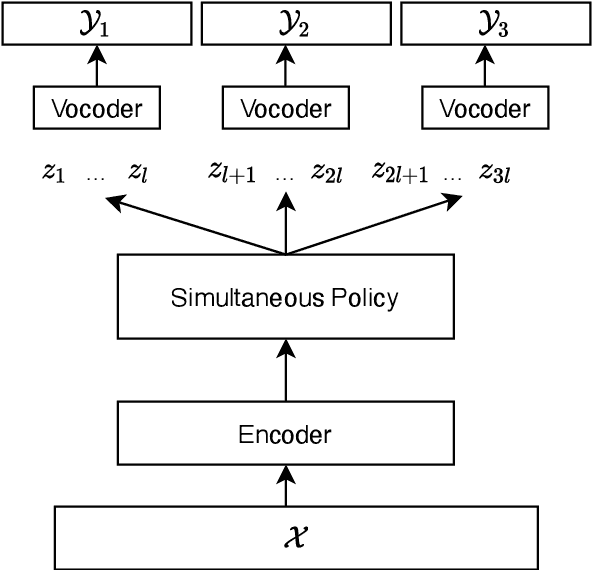
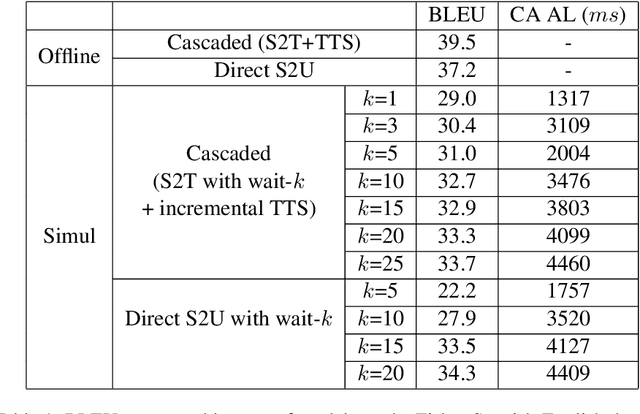
Abstract:We present the first direct simultaneous speech-to-speech translation (Simul-S2ST) model, with the ability to start generating translation in the target speech before consuming the full source speech content and independently from intermediate text representations. Our approach leverages recent progress on direct speech-to-speech translation with discrete units. Instead of continuous spectrogram features, a sequence of direct representations, which are learned in a unsupervised manner, are predicted from the model and passed directly to a vocoder for speech synthesis. The simultaneous policy then operates on source speech features and target discrete units. Finally, a vocoder synthesize the target speech from discrete units on-the-fly. We carry out numerical studies to compare cascaded and direct approach on Fisher Spanish-English dataset.
 Add to Chrome
Add to Chrome Add to Firefox
Add to Firefox Add to Edge
Add to Edge